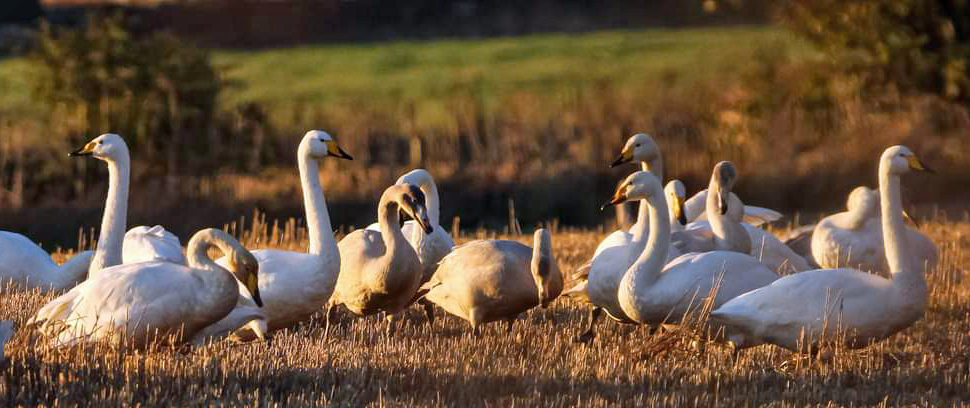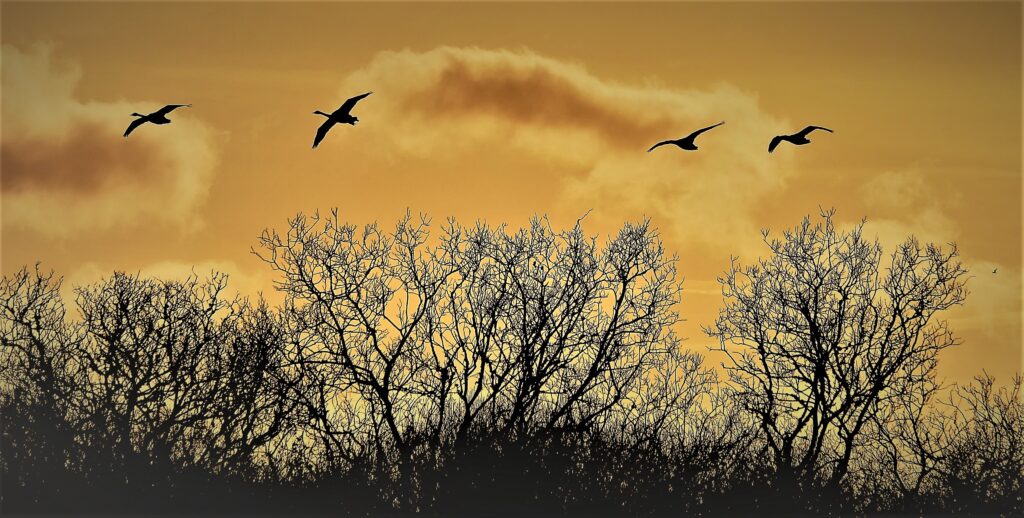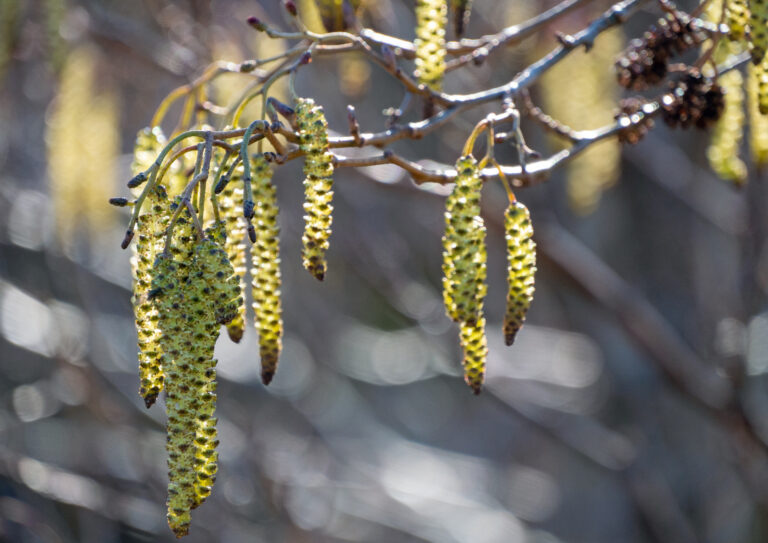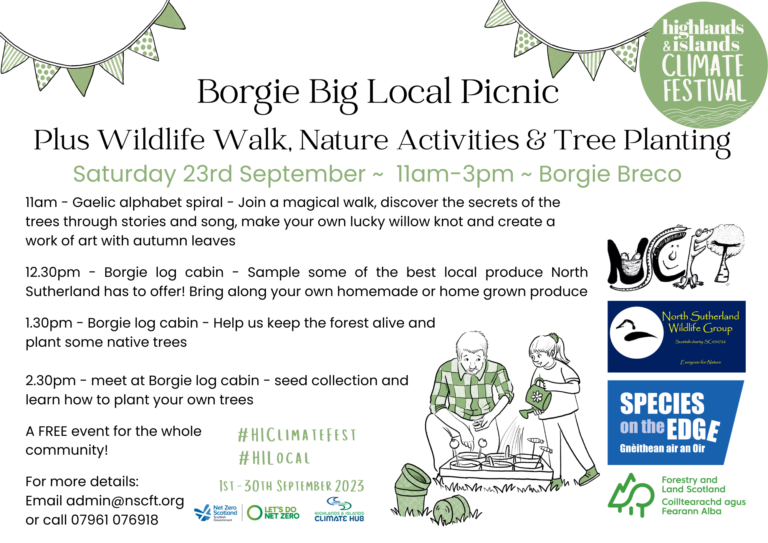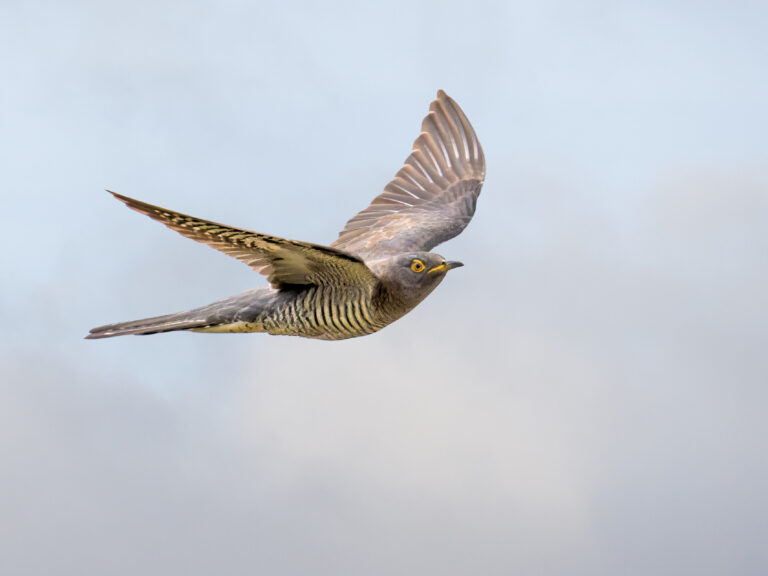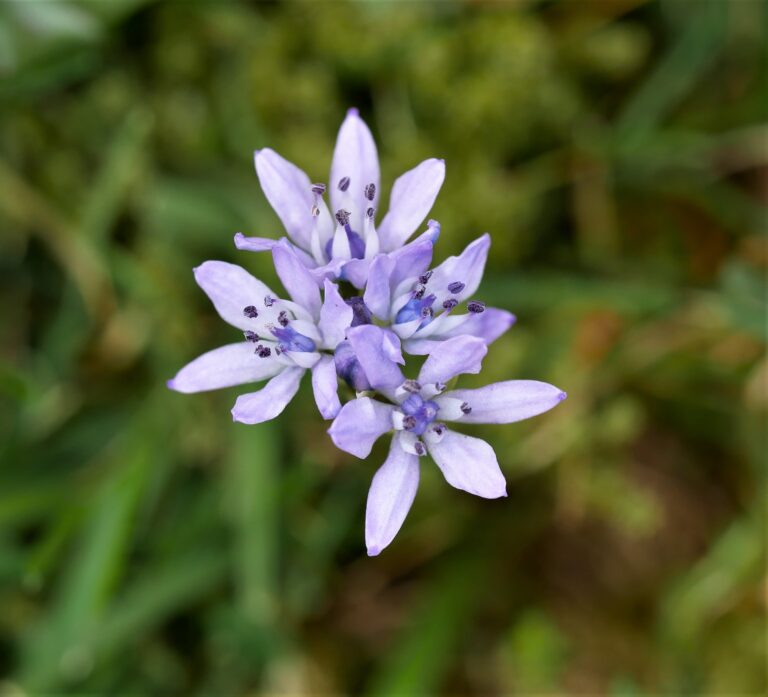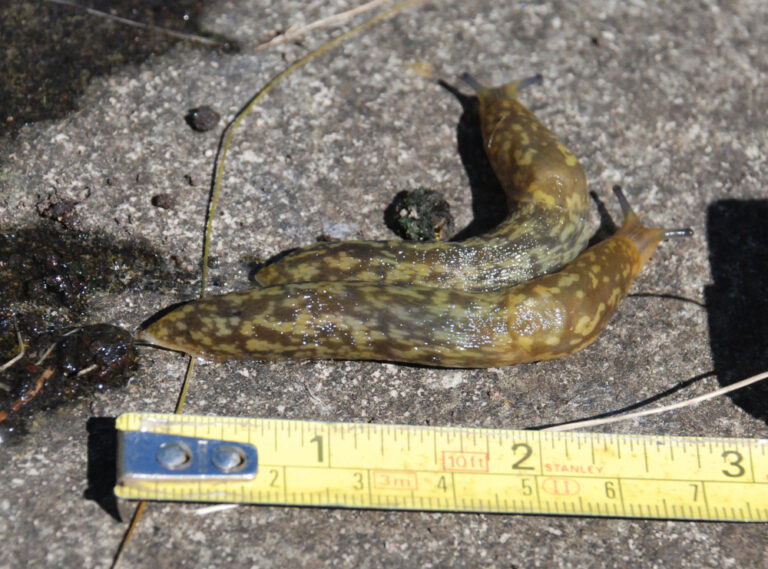By Susan Kirkup
Name: Whooper Swan (Cygnus cygnus)
Gaelic: Eala Bhan
Protection status:
The winter population and small breeding numbers make the Whooper swan an Amber List species. It is also a Schedule 1 listed bird, protected in the UK under the Wildlife and Countryside Act 1981, meaning it is illegal to disturb it.
Population:
World population is an estimated 180,000 according to the IUCN (International Union for Conservation of Nature ) Red List. The Icelandic population is estimated as 43,000 (2020) and approximately 30,000 – 35,000 of these birds migrate from Iceland to the UK each winter. An estimated 30 pairs are resident (mostly in Scotland) and breed here.
Statistics:
Length 140-160 cm.
Wingspan 205-235cm.
Weight: Adults between 8 and 14kg depending on sex . An adult male was recorded in Denmark at 15.5kg
Average lifespan: 9 years.
What to look for:
I have the Collins Bird Guide App on my phone, the Whooper swan is listed under wildfowl and the first word of the description is ‘Huge’. This is a very large bird.
Adult birds are distinguished by their white plumage, long neck and general size. They have a distinctive wedge shaped yellow and black bill with the yellow colouration covering most of the bill past the nostril area. Male and female adult whooper swans look similar although the female is slightly smaller.
Most ID guides mention that in Spring the neck and head can become stained a reddish-brown colour due to the iron content in the sediment and water in which they feed
Juvenile whooper swan plumage is grey-brown in colour. They have very pale yellow and pink bills with a black tip and edging. They reach adult white plumage before their second winter.
The general overall impression (or ‘Jizz’ in birding terms) of an adult Whooper is : A large swan, with a triangular yellow bill patch, and a straight-necked look.
This compares with our native wild Mute swan which is similar in size but has an orange bill with a black base and obvious black lump on the forehead at the base of the bill. A mute swan typically holds its neck in a bent S-shape posture when swimming. Upended in the water Mute swans have an obvious long pointed tail, Whoopers have a shorter more squared off tail.
The main confusion wild species is the Bewick swan (sometimes referred to as the Tundra swan), another UK winter visitor from the Russian Arctic tundra. These birds are occasionally spotted in Scotland on the east coast, probably passing through, but predominately settle for the winter much further south in England. They look like a small version of the Whooper, the best way to identify single birds is by the different bill markings. Bewick swans have more black and less yellow on their bills, the black colouration spreading past the nostril area (the opposite of the Whooper).
In Scotland and particularly in North Sutherland and Caithness if you spot a swan with a yellow bill it will almost certainly be a Whooper swan.
BTO winter Swan ID guide A useful video link showcasing all three wild swans.
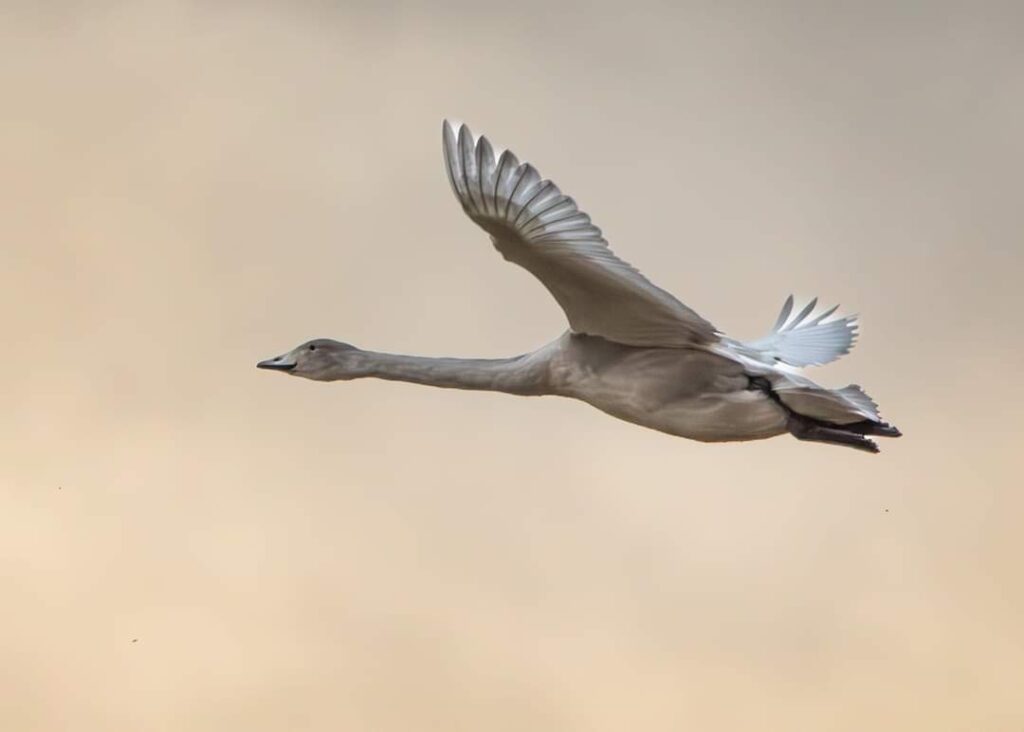
When to look:
Time of Year : October – April
As summer ends and autumn begins, the cooler temperatures and shorter days herald the arrival of many migrant birds to our northern shores.
Amongst these is the Whooper swan, a winter visitor to Scotland, migrating from Iceland in late autumn and returning North to breeding grounds there in the Spring.
An estimate of 30,000 to 35,000 make their home in the UK over the winter months, with approx. 4,000 remaining in Scotland. Many will fly to Ireland for part of the winter and then return to the Highlands before heading back to Iceland in the Spring.
During this migration the swans will fly nonstop covering distances of over 500 miles (800 km). They are known to fly at altitudes of 500 to 1700 metres over oceans dropping to a lower altitude upon reaching landfall, when they will land to rest.
Whooper swans undertake their migration journey to Scotland in family groups, and they often return to the same overwintering sites each year.
Where to look:
Whooper swans can be seen at various locations across Scotland during the migration season from October to April. There are several RSPB reserves favoured by overwintering Whoopers, including Lochwinnoch (west of Glasgow), Baron’s Haugh (Glasgow), Loch Leven (Kinross), and Loch of Strathbeg in Aberdeenshire, near Fraserburgh, one of my favourite locations to see them.
Whoopers can also be seen in many locations here on the North coast, particularly in Caithness where there are lochs and convenient grazing areas for them. Broubster Reserve near Loch Calder being one of them.
Adult Whooper swans feed in shallow water on aquatic plants and roots, using their webbed feet to dig around in the mud. They also feed in saltwater and tidal environments, usually at low tide eating common eelgrass and seaweed and graze on farmland, eating leftover grains and potatoes in autumn and feeding on grass from mid-winter to Spring.
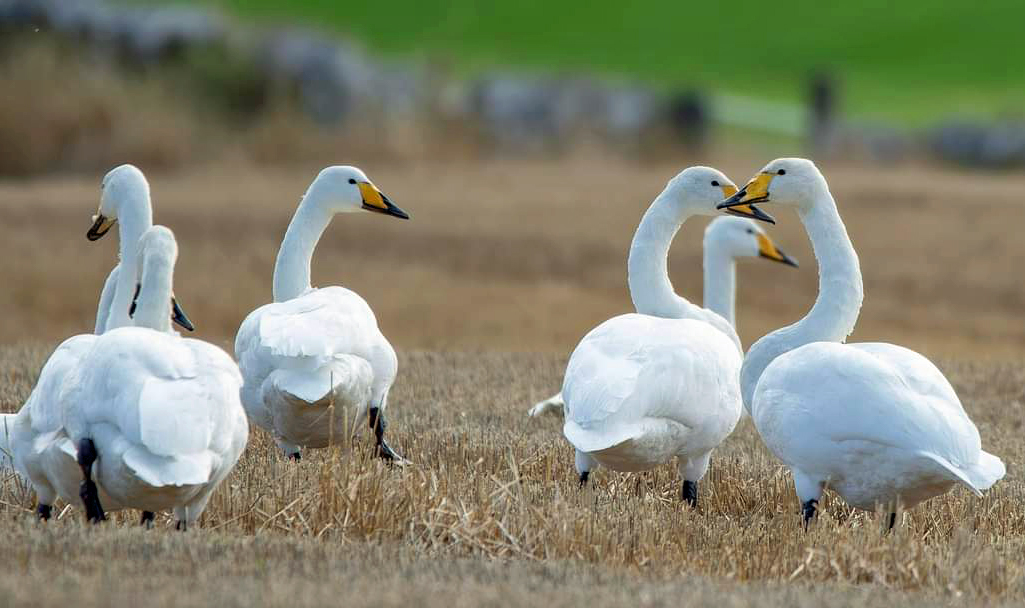
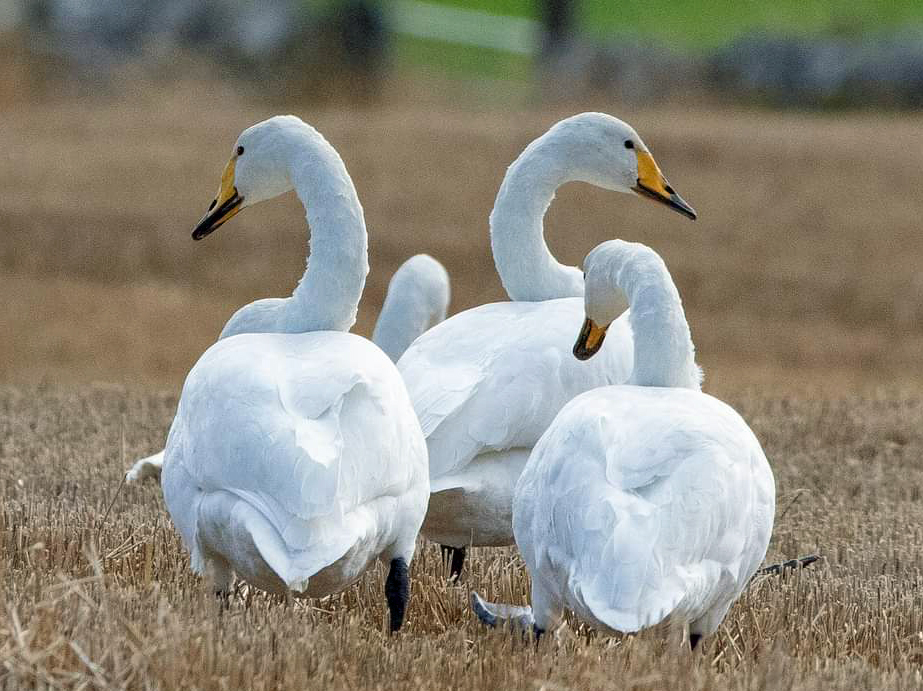
During the winter months they are social birds and can be spotted in large flocks. Look in fields, wetlands and estuaries where they will be foraging for food during the day. In the late afternoon / early evening Whoopers return to open bodies of water to roost.
They are very vocal birds and have a distinctive ‘bugling’ call when in flight and also a soft ‘whoop, whoop’ contact call. They display various signals to each other often to indicate preparation to take flight. These signals can take the form of ‘head pumping’, increased calling and wing flapping.
Often flocks will increase the level and intensity of signalling behaviour to build a level of excitement and co-ordination enabling a mass synchronised take-off. After landing Whoopers often display greetings to each other again by head bobbing, calling and wing flapping.
Listen for their calls and watch as they fly, usually quite low overhead, often low enough to hear the soft hissing sound of their wings as they pass over. It’s a particularly impressive sight. If flying in large groups they move in a typical ‘V’ formation.
Interesting Whooper Facts:
- The Whooper swans migrating to Scotland come from their breeding grounds in Iceland.
- Whoopers can also be found breeding in Northern Scandinavia, North West Russia, Western Siberia and many of the Baltic countries. The East Asia breeding Whoopers overwinter mainly in Japan where they are known as the “Angels of Winter”.
- The Whooper swan is the national bird of Finland and features on their 1 Euro coin.
- The oldest Finnish swan on record lived to be 24 years old.
- WHOOPER’ or ‘HOOPER’? There appear to be two ways to pronounce this species name, either with a silent ‘W’ or not. Back in November 2021 we posted the question to members on the North Sutherland Wildlife Group Facebook page and got ten responses, four for ‘Whooper ‘ and six for ‘Hooper’.
- Migrating Whooper swans have been recorded reaching heights above 8,000 m.
- 40 percent of swans die in their first year of life, according to bird ringing data.
- The most common cause of death in adult Whooper Swans is collision with power lines.
- Both males and females build the nests near water which are large mounds constructed from plant matter such as reeds, moss and lichen.
- Whooper swans lay 4-6 off-white eggs which are incubated by the female for 35-40 days while the male guards the nest.
- Chicks fledge at 3 months and can fly after another 1-2 months.
Sources:
All images copyrighted.





